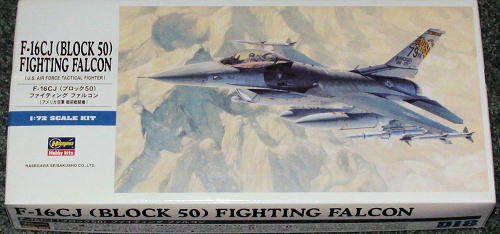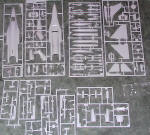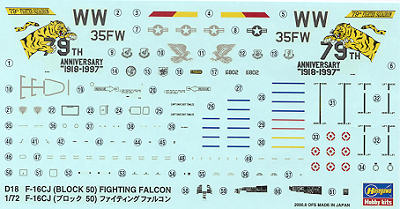
| KIT: | Hasegawa 1/72 F-16CJ (Block 50) |
| KIT #: | 00448 |
| PRICE: | $ |
| DECALS: | Two options |
| REVIEWER: | Scott Van Aken |
| NOTES: | Base boxing, 2000 |

| HISTORY |
We should be pretty much aware of the importance of the F-16 to not only the United States, but also numerous nations world wide. Though not the lightweight fighter it was originally touted to be, it has served in several conflicts and done so with distinction. In the US, the F-16A versions are pretty much out of the inventory, with many having been refurbished and sold. Even early C models are headed for storage at this writing.
Block 50/52 (F-16 CJ/DJ) aircraft were first delivered in late 1991, the aircraft equipped with improved GPS/INS. The aircraft can carry a further batch of advanced missiles; the AGM-88 HARM missile, JDAM, JSOW and WCMD. Block 50 aircraft are powered by the F110-GE-129 while the Block 52 jets use the F100-PW-229.
| THE KIT |
 Here is yet another nicely done Hasegawa 'variant' kit. It starts with the basic F-16A molds of the mid 1980s and by adding in the required sprues, provides us with one of the much newer F-16CJ versions.
Here is yet another nicely done Hasegawa 'variant' kit. It starts with the basic F-16A molds of the mid 1980s and by adding in the required sprues, provides us with one of the much newer F-16CJ versions.
Despite years and years of runs, the sprues are still in very good condition. Naturally, you'll find some flash with the base sprues, though that is actually minimal and confined to just a few parts. Even the newest sprues suffer from ejection pin marks on the missile bodies, inner gear doors, landing gear, wheels, and other parts. Typical of Hasegawa 1/72 kits, the cockpit is a bit basic with decals for instruments and a very plain seat. I'd suggest replacing the seat as a priority. An updated pilot figure is provided should you wish to use it to fill the cockpit.
Among the different bits included are the 'big mouth' intake, GE afterburner, bulged gear doors, wider wheels, and updated weapons that include AMRAAMs and a pair of HARMS along with their pylons. A new chin sensor pod is also included. Of course, you get all the F-16A stuff like drop tanks, Sidewinders, and bombs along with their specific pylons. There is a nicely done canopy  and boarding ladder, though no canopy actuating mechanism. Since the kit includes the F-16A stuff, you could also do a 'small mouth' Block 52 aircraft, assuming you have the right markings.
and boarding ladder, though no canopy actuating mechanism. Since the kit includes the F-16A stuff, you could also do a 'small mouth' Block 52 aircraft, assuming you have the right markings.
Instructions are typical of Hasegawa and very well done. Color references are for Gunze paints with FS numbers also provided. The markings are for two aircraft. Both are listed as Block 50 types. One is the box art aircraft from the 79th FS at Shaw AFB in 1997 for the Tiger Meet. The other is a boss bird from the 35 FW at Misawa. Both are shown in the three greys scheme. Decals are well printed and include a full stencil suite. They seem to be the 'standard' Japanese type that do not like setting solutions so be sure to use very hot water when applying them.
| CONCLUSIONS |
So, we have yet another fine addition to the Hasegawa family of 1/72 F-16s. Probably the only complaint one could make is that the upper fuselage panel lines are those of an F-16A/B and not of an F-16C/D. A nit-pick? Probably, but those who work around the aircraft will notice. The newer Revell AG F-16 kit has gotten a lot of rave reviews and may well be superior to this one, but the Hasegawa kit is easy to find almost anywhere and can be purchased for a most reasonable price from shops and from vendors and swap meets.
July 2006
Preview kit courtesy of your editor.
If you would like your product reviewed fairly and fairly quickly by asite that has over 300,000 visitors a month, please contactme or see other details in the